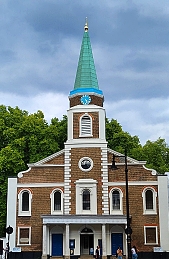MY UNCLE SVEN Rindl (1921-2007) was a structural engineer. He was involved in the construction of the building on the west side of Mayfair’s Grosvenor Square, which used to house the Embassy of the USA until recently. About yards south of the former embassy building, there is another place associated with the USA on South Audley Street. Far older than the embassy, this is the Grosvenor Chapel, whose foundation stone was laid in 1730 by Sir Richard Grosvenor (1689-1732), the local landowner. The relatively simple brick and stone church with some neo-classical features was ready for use in 1731. When the church’s 99-year lease ran out in 1829, it became adopted as a chapel-of-ease (i.e., a chapel or church within a parish, other than the parish church) to St George’s Hanover Square.
Until very recently, I had often passed the Grosvenor Chapel when going to and from The Nehru Centre, also on South Audley Street, but had never entered it. Yesterday (26th of August 2022), the doors were open and, being early for a dance performance at the Nehru Centre, I looked inside the chapel. Its interior is simply decorated. The wide nave lies below a barrel-vaulted, plastered ceiling. Galleries supported by columns with Ionic capitals flank the north and south sides of the nave. The chancel is separated from the nave by a screen with openings, each of which is flanked by pairs of Ionic columns. The screen was added by the architect John Ninian Comper (1864-1960) when he remodelled the church’s interior in 1912.Ionic columns with their bases on the gallery support the ceiling of the nave. Windows (with plain glass panes) on two levels, both below and above the galleries, give the chapel good natural illumination. In summary, the simple, white-painted chapel, though not large, feels spacious. Its simplicity is a complete contrast to its neighbour, the flamboyant Gothic Revival style Catholic Church of the Immaculate Conception.
An inscribed stone plaque on the west front of the chapel records its American connection. The words on it are:
“In this chapel the Armed Forces of the United States of America held Divine Service during the Great War of 1939 to 1945 and gave thanks to God for the Victory of the Allies”
The American General Dwight David Eisenhower (1890-1969) was amongst those who worshipped there during WW2. Many years before that, another person connected with the USA, John Wilkes (1725-1797) was buried in the chapel. Wilkes, a radical journalist and politician, was a supporter of the American rebels during the American War of Independence.
America (i.e., the USA) has been associated with Mayfair since it gained independence from the British. Its first embassy was in a house in Mayfair belonging to John Adams (1735-1786), who was the first US Minister to the Court of St James (between 1785 and 1788). The embassy’s Chancery moved several times before 1938, when it was housed in 1 Grosvenor Square, now the home of the Canadian High Commission. Thus, during WW2, it was close to the Grosvenor Chapel. The embassy building, in whose construction my uncle was involved, was designed by the architect Eero Saarinen (1910-1961), and completed in 1960. By January 2018, the embassy had shifted from Grosvenor Square to a newly constructed edifice across the Thames at Nine Elms.
Returning to the small chapel, a small note about its name. The place’s website (www.grosvenorchapel.org.uk) explained:
“It retains its title of Chapel because it is not, and never has been a parish church, and its continuing existence is entirely dependent upon the generosity of those who worship here regularly or visit from time to time.”

